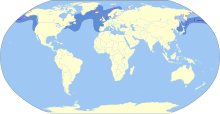| Common murre | |
|---|---|

| |
| Bird calls recorded in Pembrokeshire, Wales | |
| Scientific classification | |
| Domain: | Eukaryota |
| Kingdom: | Animalia |
| Phylum: | Chordata |
| Class: | Aves |
| Order: | Charadriiformes |
| Family: | Alcidae |
| Genus: | Uria |
| Species: | U. aalge
|
| Binomial name | |
| Uria aalge (Pontoppidan, 1763)
| |

| |
| Synonyms | |
| |
The common murre or common guillemot (Uria aalge) is a large auk. It has a circumpolar distribution, occurring in low-Arctic and boreal waters in the North Atlantic and North Pacific. It spends most of its time at sea, only coming to land to breed on rocky cliff shores or islands.
Common murres are fast in direct flight but are not very agile. They are highly mobile underwater using their wings to 'fly' through the water column, where they typically dive to depths of 30–60 m (100–195 ft). Depths of up to 180 m (590 ft) have been recorded.
Common murres breed in colonies at high densities. Nesting pairs may be in bodily contact with their neighbours. They make no nest; their single egg is incubated between the adult's feet on a bare rock ledge on a cliff face. Eggs hatch after ~30 days incubation. The chick is born downy and can regulate its body temperature after 10 days. Some 20 days after hatching the chick leaves its nesting ledge and heads for the sea, unable to fly, but gliding for some distance with fluttering wings, accompanied by its male parent. Male guillemots spend more time diving, and dive more deeply than females during this time. Chicks are capable of diving as soon as they hit the water. The female stays at the nest site for some 14 days after the chick has left.
Both male and female common murres moult after breeding and become flightless for 1–2 months. Some populations have short migration distances, instead remaining close to the breeding site year-round. Such populations return to the nest site from autumn onwards. Adult birds balance their energetic budgets during the winter by reducing the time that they spend flying and are able to forage nocturnally.
- ^ BirdLife International (2018). "Uria aalge". IUCN Red List of Threatened Species. 2018: e.T22694841A132577296. doi:10.2305/IUCN.UK.2018-2.RLTS.T22694841A132577296.en. Retrieved 12 November 2021.
- ^ "Uria aalge: Guillemot". National Biodiversity Network (NBN) Atlas. Retrieved 2020-01-31.
